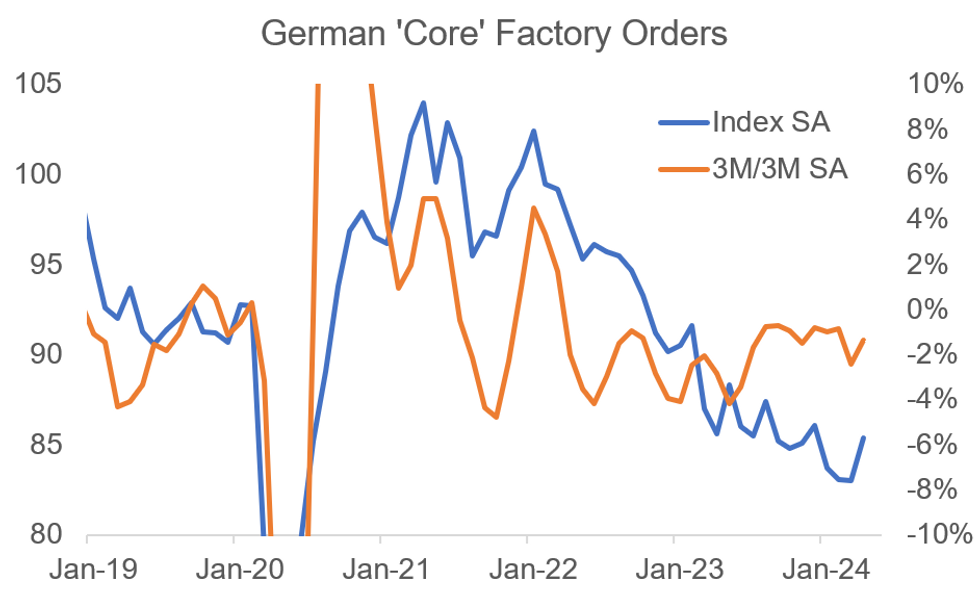-
Policy
Policy
Exclusive interviews with leading policymakers that convey the true policy message that impacts markets.
LATEST FROM POLICY: -
EM Policy
EM Policy
Exclusive interviews with leading policymakers that convey the true policy message that impacts markets.
LATEST FROM EM POLICY: -
G10 Markets
G10 Markets
Real-time insight on key fixed income and fx markets.
Launch MNI PodcastsFixed IncomeFI Markets AnalysisCentral Bank PreviewsFI PiFixed Income Technical AnalysisUS$ Credit Supply PipelineGilt Week AheadGlobal IssuanceEurozoneUKUSDeep DiveGlobal Issuance CalendarsEZ/UK Bond Auction CalendarEZ/UK T-bill Auction CalendarUS Treasury Auction CalendarPolitical RiskMNI Political Risk AnalysisMNI Political Risk - US Daily BriefMNI Political Risk - The week AheadElection Previews -
Emerging Markets
Emerging Markets
Real-time insight of emerging markets in CEMEA, Asia and LatAm region
-
Commodities
-
Credit
Credit
Real time insight of credit markets
-
Data
-
Global Macro
Global Macro
Actionable insight on monetary policy, balance sheet and inflation with focus on global issuance. Analysis on key political risk impacting the global markets.
Global MacroDM Central Bank PreviewsDM Central Bank ReviewsEM Central Bank PreviewsEM Central Bank ReviewsBalance Sheet AnalysisData AnalysisEurozone DataUK DataUS DataAPAC DataInflation InsightEmployment InsightGlobal IssuanceEurozoneUKUSDeep DiveGlobal Issuance Calendars EZ/UK Bond Auction Calendar EZ/UK T-bill Auction Calendar US Treasury Auction Calendar Global Macro Weekly -
About Us
To read the full story
Sign up now for free trial access to this content.
Please enter your details below.
Why MNI
MNI is the leading provider
of intelligence and analysis on the Global Fixed Income, Foreign Exchange and Energy markets. We use an innovative combination of real-time analysis, deep fundamental research and journalism to provide unique and actionable insights for traders and investors. Our "All signal, no noise" approach drives an intelligence service that is succinct and timely, which is highly regarded by our time constrained client base.Our Head Office is in London with offices in Chicago, Washington and Beijing, as well as an on the ground presence in other major financial centres across the world.
Real-time Actionable Insight
Get the latest on Central Bank Policy and FX & FI Markets to help inform both your strategic and tactical decision-making.
Free AccessMNI ASIA OPEN: Nov Job Gains, Fed Blackout, CPI/PPI Ahead
MNI UST Issuance Deep Dive: Dec 2024
MNI US Employment Insight: Soft Enough To Keep Fed Cutting
MNI ASIA MARKETS ANALYSIS: Jobs Data Green Lights Rate Cuts
Headine Fall Blurs EZ / Investment-Driven 'Core' Recovery
German factory orders declined 0.2% M/M in April, softer than the +0.6% expected and there was also a downward revision to the March print of -0.4pp to -0.8% M/M. The underlying 'core' measure pointed towads some recovery, though.
- Factory orders also declined on a Y/Y basis, by 1.6% (vs +0.3% cons; -2.4% prior, revised from -1.9%), with the renewed improvement in the annual comparison due to base effects.
- Core (ex-large ticket items) orders, a better measure of underlying activity, jumped 2.9% M/M in April (vs -0.1% prior, revised from +0.1%); its less volatile 3M/3M measure also printed stronger than before, at -1.3% in the 3-months to April (-2.4% prior) but this measure remained in negative territory for the 24th consecutive month.
- The breakdown showed the 'core' rise was driven by investment and non-durable goods orders, which came in at +5.2% M/M (vs +0.5% prior; highest rate since the 2020 pandemic recovery) and +4.0% M/M (vs +1.5% prior), respectively. Durable goods orders meanwhile dragged the overall print lower, at -4.3% M/M (vs +3.9% prior).
- Looking at an international split, domestic 'core' orders increased 0.7% M/M (vs -2.2% prior), while foreign orders jumped 4.5% M/M (vs +1.2% prior), driven by EZ orders at +7.4% M/M (vs +2.0% prior).
- Real manufacturing turnover meanwhile decreased 0.9% M/M in April (-0.4% prior, revised from -0.7%), opening up some slight downside risks to the consensus forecast of +0.2% M/M re April's factory orders data.
- Overall, the data adds to the view that there seems to be a gradual recovery of German economic activity forming - but that this recovery is, to a significant extent, externally-driven.
 MNI, Destatis
MNI, Destatis
To read the full story
Sign up now for free trial access to this content.
Please enter your details below.
Why MNI
MNI is the leading provider
of intelligence and analysis on the Global Fixed Income, Foreign Exchange and Energy markets. We use an innovative combination of real-time analysis, deep fundamental research and journalism to provide unique and actionable insights for traders and investors. Our "All signal, no noise" approach drives an intelligence service that is succinct and timely, which is highly regarded by our time constrained client base.Our Head Office is in London with offices in Chicago, Washington and Beijing, as well as an on the ground presence in other major financial centres across the world.
